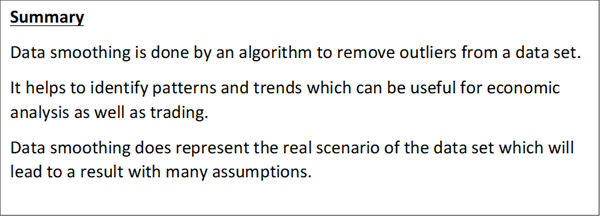Definition
Related Definitions
Data Smoothing
What do you mean by Data Smoothing?
Data smoothing alludes to a measurable methodology of dispensing anomalies from datasets to make the examples more recognizable. It is accomplished utilizing calculations to eliminate statistical disproportions from datasets.
Data smoothing can help anticipate patterns, for example, those found in stock prices, just as in financial examination. Data smoothing is proposed to overlook one-time exceptions and consider the impacts of irregularity.

Understanding Data Smoothing
At the point when information is secured and structured, it very well may be controlled to eliminate or decrease any unpredictability or some other kind of commotion. This is called data smoothing.
The thought behind data smoothing is that it can distinguish worked-on changes to help foresee various patterns and examples. It acts as a guide for analysts who need to analyze a ton of information—that can frequently be convoluted to process—to discover designs they would not in any case see. It could be modified to diminish or bring out any broad changes or other measurable commotions during the assemblage of information.
Such a methodology utilizes simple enhancements to estimate different examples better. It centers around making an essential course for the principal information by staying away from any unstable bits of information and drawing a smoother bend across the information.
To clarify with a visual portrayal, envision a one-year diagram for Company X's stock. Every individual high point on the outline for the stock can be decreased while raising all the lower focuses. This would make a smoother bend, subsequently helping a financial backer make expectations about how the stock may act later on.

Source: Copyright © 2021 Kalkine Media
A frequently referred to the illustration of information smoothing in business accounting is to make a section of doubt doubts by changing bad debt expense from one period then onto the next. For instance, an organization expects not to install specific products for more than two accounting periods; $5,000 in the first reporting period and $4,000 in the second one.
If the first period is relied upon to have a high income, the organization may incorporate the aggregate sum of $10,000 as the remittance for dubious records in that announcing period. This would increase the bad debt expense by $10,000 and decrease total income by $10,000. This would accordingly streamline a significant league salary period by diminishing pay. Companies must utilize judgment and legitimate accounting strategies while changing any records.
- Methods of Data Smoothing
The random walk, simple moving average, and simple exponential and exponential average are a portion of the strategies that can be utilized for information smoothing. The usually used techniques are talked about beneath:
- Simple Exponential
The remarkable straightforward technique is a mainstream information smoothing strategy due to the simplicity of estimation, adaptability, and excellent execution. It is an average computation for appointing the exponentially declining loads starting with the latest perception. The technique can be effortlessly applied. The expectations are considered exact since the distinction between the genuine projections and what truly happens is represented in the straightforward remarkable methodology. The strategy isn't equipped for overseeing patterns well. Subsequently, it is utilized when repetitive varieties are absent.
- Moving Average
The moving average methodology is best utilized when there is slight or no occasional variation. Moving average data smoothing is used for isolating arbitrary variety. Financial analysts use a straightforward information smoothing approach to help evaluate the basic examples in building licenses, just as other unpredictable datasets. Moving averages merges the month-long information into time units longer than a month, like a normal of details of a while.
- Random Walk
The random walk model is usually used to portray the conduct of monetary instruments, like stocks. A few financial backers accept that there is no connection between past development in a security's cost and future development. Random walk smoothing assumes that future information focuses will approach the last accessible information point, in addition to an irregular variable. Specialized and crucial investigators can't help contradicting this thought; they accept future developments can be extrapolated by inspecting past patterns.
- Exponential Moving Average
In the exponential moving average method, weights are applied to historical data utilizing the exponential smoothing technique. It zeros in on the most recent information perceptions. Thus, the exponential moving average reacts quicker to value changes than the basic moving average strategy. Moreover, the expectations need the past unpredictability forecast and the past cycle value shift. The estimate is not required to be calculated again using price returns historical data.
Frequently Asked Questions
- What are the advantages and disadvantages of Data Smoothing?
- Data smoothing strategies are straightforward. It can help in distinguishing patterns in organizations, financial protections, and the economy.
- Data smoothing can help uncover designs in confounded information. It aids the expectation of the future movements of the data. If the recipient does need certain points, those specific data points can be eliminated from the data set.
- It additionally assists with producing smooth diagrams that portray patterns and examples.
The disadvantages are as follows:
- Data smoothing doesn't offer an understanding of the topics or examples it assists with perceiving. It can likewise add to certain information focuses being neglected by zeroing in on others.
- In some cases, data smoothing may take out usable information. It might prompt wrong figures if the informational collection is occasional and not totally and not complete the true reflection of the population or the data set. Additionally, data smoothing can be inclined to significant disruption from the outliers present in the data.
